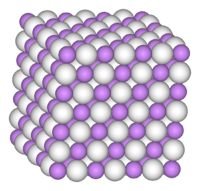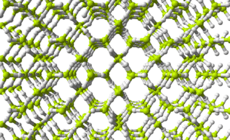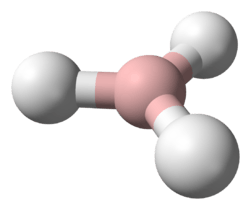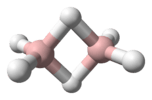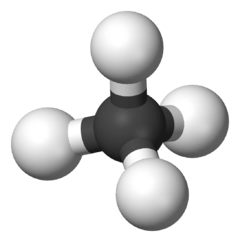Properties of water
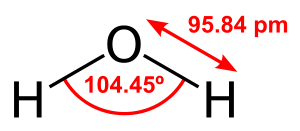 | |||
| |||
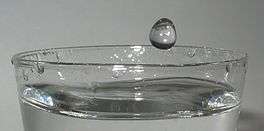 | |||
| Names | |||
|---|---|---|---|
| IUPAC name
water, oxidane | |||
| Other names
Hydrogen oxide, Dihydrogen monoxide (DHMO), Hydrogen monoxide, Dihydrogen oxide, Hydrogen hydroxide (HH or HOH), Hydric acid, Hydrohydroxic acid, Hydroxic acid, Hydrol,[1] μ-Oxido dihydrogen | |||
| Identifiers | |||
| 7732-18-5 | |||
| 3D model (Jmol) | Interactive image | ||
| 3587155 | |||
| ChEBI | CHEBI:15377 | ||
| ChEMBL | ChEMBL1098659 | ||
| ChemSpider | 937 | ||
| 117 | |||
| PubChem | 962 | ||
| RTECS number | ZC0110000 | ||
| UNII | 059QF0KO0R | ||
| |||
| |||
| Properties | |||
| H 2O | |||
| Molar mass | 18.01528(33) g/mol | ||
| Appearance | White solid or almost colorless, transparent, with a slight hint of blue, crystalline solid or liquid[2] | ||
| Odor | None | ||
| Density | Liquid: 999.9720 kg/m3 ≈ 1 tonne/m3 = 1 kg/l = 1 g/cm3 ≈ 62.4 lb/ft3 (maximum, at ~4 °C) Solid: 917 kg/m3 = 0.917 tonne/m3 = 0.917 kg/l = 0.917 g/cm3 ≈ 57.2 lb/ft3 | ||
| Melting point | 0.00 °C (32.00 °F; 273.15 K) [lower-alpha 1] | ||
| Boiling point | 99.98 °C; 211.96 °F; 373.13 K [3][lower-alpha 1] | ||
| Solubility | Poorly soluble in haloalkanes, aliphatic and aromatic hydrocarbons, ethers.[4] Improved solubility in carboxylates, alcohols, ketones, amines. Miscible with methanol, ethanol, isopropanol, acetone, glycerol. | ||
| Vapor pressure | 3.1690 kilopascals or 0.031276 atm[5] | ||
| Acidity (pKa) | 13.995[6][lower-alpha 2] | ||
| Basicity (pKb) | 13.995 | ||
| Thermal conductivity | 0.6065 W/m·K[8] | ||
| Refractive index (nD) |
1.3330 (20°C)[9] | ||
| Viscosity | 0.890 cP[10] | ||
| Structure | |||
| Hexagonal | |||
| C2v | |||
| Bent | |||
| 1.8546 D[11] | |||
| Thermochemistry | |||
| 75.375 ± 0.05 J/mol·K[12] | |||
| Std molar entropy (S |
69.95 ± 0.03 J/mol·K[12] | ||
| Std enthalpy of formation (ΔfH |
-285.83 ± 0.040 kJ/mol[4][12] | ||
| Gibbs free energy (ΔfG˚) |
-237.24 kJ/mol[4] | ||
| Hazards | |||
| Main hazards | Drowning Water intoxication Avalanche (as snow) (see also Dihydrogen monoxide hoax) | ||
| NFPA 704 | |||
| Flash point | Non-flammable | ||
| Related compounds | |||
| Other cations |
Hydrogen sulfide Hydrogen selenide Hydrogen telluride Hydrogen polonide Hydrogen peroxide | ||
| Related solvents |
Acetone Methanol | ||
| Related compounds |
Water vapor Ice Heavy water | ||
| Except where otherwise noted, data are given for materials in their standard state (at 25 °C [77 °F], 100 kPa). | |||
| | |||
| Infobox references | |||
Water (H
2O) is a polar inorganic compound that is at room temperature a tasteless and odorless liquid, nearly colorless with a hint of blue. The simplest hydrogen chalcogenide, it is by far the most studied chemical compound and is described as the "universal solvent" for its ability to dissolve many substances.[13][14] This allows it to be the "solvent of life".[15] It is the only common substance to exist as a solid, liquid, and gas in nature.[16]
Water molecules form hydrogen bonds with each other and are strongly polar. This polarity allows it to separate ions in salts and strongly bond to other polar substances such as alcohols and acids, thus dissolving them. Its hydrogen bonding causes its many unique properties, such as having a solid form less dense than its liquid form, a relatively high boiling point of 100 °C for its molar mass, and a high heat capacity.
Water is amphoteric, meaning it is both an acid and a base—it produces H+
and OH−
ions by self ionization. This regulates the concentrations of H+
and OH−
ions in water.
Due to water being a very good solvent, it is rarely pure and some of the properties of impure water can vary from those of the pure substance. However, there are also many compounds that are essentially, if not completely, insoluble in water, such as fats, oils and other nonpolar substances.
Nomenclature
The accepted IUPAC name of water is oxidane or simply water,[17] or its equivalent in different languages, although there are other systematic names which can be used to describe the molecule. Oxidane is only intended to be used as the name of the mononuclear parent hydride used for naming derivatives of water by substituent nomenclature.[18] These derivatives commonly have other recommended names. For example, the name hydroxyl is recommended over oxidanyl for the –OH group. The name oxane is explicitly mentioned by the IUPAC as being unsuitable for this purpose, since it is already the name of a cyclic ether also known as tetrahydropyran.[19][20]
The simplest systematic name of water is hydrogen oxide. This is analogous to related compounds such as hydrogen peroxide, hydrogen sulfide, and deuterium oxide (heavy water).
The polarized form of the water molecule, H+
OH−
, is also called hydron hydroxide by IUPAC nomenclature.[21]
In keeping with the basic rules of chemical nomenclature, water would have a systematic name of dihydrogen monoxide,[22] but this is not among the names published by the International Union of Pure and Applied Chemistry.[17] It is a rarely used name of water, and mostly used in various hoaxes or spoofs that call for this "lethal chemical" to be banned, such as in the dihydrogen monoxide hoax.
Other systematic names for water include hydroxic acid, hydroxylic acid, and hydrogen hydroxide, using acid and base names.[lower-alpha 3] None of these exotic names are used widely.
Properties
Water is the chemical substance with chemical formula H
2O; one molecule of water has two hydrogen atoms covalently bonded to a single oxygen atom.[23]
Water is a tasteless, odorless liquid at ambient temperature and pressure, and appears colorless in small quantities, although it has its own intrinsic very light blue hue.[24][2] Ice also appears colorless, and water vapor is essentially invisible as a gas.
Water is primarily a liquid under standard conditions, which is not predicted from its relationship to other analogous hydrides of the oxygen family in the periodic table, which are gases such as hydrogen sulfide. The elements surrounding oxygen in the periodic table, nitrogen, fluorine, phosphorus, sulfur and chlorine, all combine with hydrogen to produce gases under standard conditions. The reason that water forms a liquid is that oxygen is more electronegative than all of these elements with the exception of fluorine. Oxygen attracts electrons much more strongly than hydrogen, resulting in a net positive charge on the hydrogen atoms, and a net negative charge on the oxygen atom. These atomic charges give each water molecule a net dipole moment. Electrical attraction between water molecules due to this dipole pulls individual molecules closer together, making it more difficult to separate the molecules and therefore raising the boiling point. This attraction is known as hydrogen bonding.
The molecules of water are constantly moving in relation to each other, and the hydrogen bonds are continually breaking and reforming at timescales faster than 200 femtoseconds (2×10−13 seconds).[25] However, these bonds are strong enough to create many of the peculiar properties of water, some of which make it integral to life.
Water can be described as a polar liquid that slightly dissociates disproportionately or self ionizes into an hydronium ion and hydroxide ion.
- 2 H
2O ⇌ H
3O+
+ OH−
The dissociation constant for this dissociation is commonly symbolized as Kw and has a value of about 10−14 at 25 °C; see here for values at other temperatures.
Water, ice, and vapor
Like many substances, water can take numerous forms, which are broadly categorized by phase of matter. The liquid phase is the most common among water's phases (within the Earth's atmosphere and surface) and is the form that is generally denoted by the word "water". The solid phase of water is known as ice and commonly takes the structure of hard, amalgamated crystals, such as ice cubes, or loosely accumulated granular crystals, like snow. For a list of the many different crystalline and amorphous forms of solid H
2O, see the article ice. The gaseous phase of water is known as water vapor (or steam), in which water takes the form of a transparent cloud. (Visible steam and clouds are, in fact, water in the liquid form as minute droplets suspended in the air.)
The fourth state of water, that of a supercritical fluid, is much less common than the other three and only rarely occurs in nature, in extremely hostile conditions. When water achieves a specific critical temperature and a specific critical pressure (647 K and 22.064 MPa), the liquid and gas phases merge to one homogeneous fluid phase, with properties of both gas and liquid. A likely example of naturally occurring supercritical water is in the hottest parts of deep water hydrothermal vents, in which water is heated to the critical temperature by volcanic plumes and the critical pressure is caused by the weight of the ocean at the extreme depths where the vents are located. This pressure is reached at a depth of about 2200 meters: much less than the mean depth of the ocean (3800 meters).[26]
Heat capacity and heats of vaporization and fusion
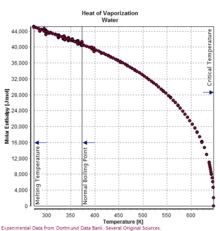
Water has a very high specific heat capacity of 4.1814 J/(g·K) at 25 °C – the second highest among all the heteroatomic species (after ammonia), as well as a high heat of vaporization (40.65 kJ/mol or 2257 kJ/kg at the normal boiling point), both of which are a result of the extensive hydrogen bonding between its molecules. These two unusual properties allow water to moderate Earth's climate by buffering large fluctuations in temperature. According to Josh Willis, of NASA's Jet Propulsion Laboratory, the oceans can absorb one thousand times more heat than the atmosphere without changing their temperature much and are absorbing 80 to 90% of the heat global warming.[27]
The specific enthalpy of fusion (more commonly known as latent heat) of water is 333.55 kJ/kg at 0 °C: the same amount of energy is required to melt ice as to warm ice from −160 °C up to its melting point or to heat the same amount of water by about 80 °C. Of common substances, only that of ammonia is higher. This property confers resistance to melting on the ice of glaciers and drift ice. Before and since the advent of mechanical refrigeration, ice was and still is in common use for retarding food spoilage.
The specific heat capacity of ice at −10 °C is 2.03 J/(g·K)[28] and the heat capacity of steam at 100 °C is 2.08 J/(g·K).[29]
Density of water and ice
.svg.png)
The density of water is about 1 gram per cubic centimetre (62 lb/cu ft): this relationship was originally used to define the gram.[30] The density varies with temperature, but not linearly: as the temperature increases, the density rises to a peak at 3.98 °C (39.16 °F) and then decreases.[31] This unusual negative thermal expansion below 4 °C (39 °F) is also observed in molten silica.[32] Regular, hexagonal ice is also less dense than liquid water—upon freezing, the density of water decreases by about 9%.[33]
These effects are due to the reduction of thermal motion with cooling, which allows water molecules to form more hydrogen bonds that prevent the molecules from coming close to each other.[31] While below 4 °C the breakage of hydrogen bonds due to heating allows water molecules to pack closer despite the increase in the thermal motion (which tends to expand a liquid), above 4 °C water expands as the temperature increases.[31] Water near the boiling point is about 4% less dense than water at 4 °C (39 °F).[33][lower-alpha 4]
Other substances that expand on freezing are acetic acid, silicon, gallium,[34] germanium, bismuth, plutonium and also chemical compounds that form spacious crystal lattices with tetrahedral coordination.
Under increasing pressure, ice undergoes a number of transitions to other allotropic forms with higher density than liquid water, such as ice II, ice III, high-density amorphous ice (HDA), and very-high-density amorphous ice (VHDA).[35][36]

The unusual density curve and lower density of ice than of water is vital to life—if water was most dense at the freezing point, then in winter the very cold water at the surface of lakes and other water bodies would sink, the lake could freeze from the bottom up, and all life in them would be killed.[33] Furthermore, given that water is a good thermal insulator (due to its heat capacity), some frozen lakes might not completely thaw in summer.[33] The layer of ice that floats on top insulates the water below.[37] Water at about 4 °C (39 °F) also sinks to the bottom, thus keeping the temperature of the water at the bottom constant (see diagram).[33]
Density of saltwater and ice
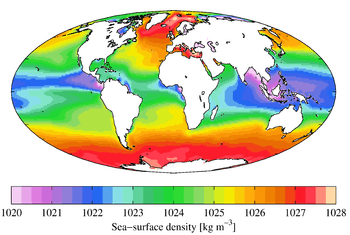
The density of salt water depends on the dissolved salt content as well as the temperature. Ice still floats in the oceans, otherwise they would freeze from the bottom up. However, the salt content of oceans lowers the freezing point by about 1.9 °C[38] (see here for explanation) and lowers the temperature of the density maximum of water to the freezing point. This is why, in ocean water, the downward convection of colder water is not blocked by an expansion of water as it becomes colder near the freezing point. The oceans' cold water near the freezing point continues to sink. So creatures that live at the bottom of cold oceans like the Arctic Ocean generally live in water 4 °C colder than at the bottom of frozen-over fresh water lakes and rivers.
As the surface of salt water begins to freeze (at −1.9 °C[38] for normal salinity seawater, 3.5%) the ice that forms is essentially salt-free, with about the same density as freshwater ice. This ice floats on the surface, and the salt that is "frozen out" adds to the salinity and density of the sea water just below it, in a process known as brine rejection. This denser salt water sinks by convection and the replacing seawater is subject to the same process. This produces essentially freshwater ice at −1.9 °C[38] on the surface. The increased density of the sea water beneath the forming ice causes it to sink towards the bottom. On a large scale, the process of brine rejection and sinking cold salty water results in ocean currents forming to transport such water away from the Poles, leading to a global system of currents called the thermohaline circulation.
Miscibility and condensation

Water is miscible with many liquids, for example ethanol in all proportions, forming a single homogeneous liquid. On the other hand, water and most oils are immiscible usually forming layers according to increasing density from the top. This can be predicted by comparing the polarity. Water being a relatively polar compound will tend to be miscible with liquids of high polarity such as ethanol and acetone, whereas compounds with low polarity will tend to be immiscible and poorly soluble such as with hydrocarbons.
As a gas, water vapor is completely miscible with air. On the other hand, the maximum water vapor pressure that is thermodynamically stable with the liquid (or solid) at a given temperature is relatively low compared with total atmospheric pressure. For example, if the vapor's partial pressure is 2% of atmospheric pressure and the air is cooled from 25 °C, starting at about 22 °C water will start to condense, defining the dew point, and creating fog or dew. The reverse process accounts for the fog burning off in the morning. If the humidity is increased at room temperature, for example, by running a hot shower or a bath, and the temperature stays about the same, the vapor soon reaches the pressure for phase change, and then condenses out as minute water droplets, commonly referred to as steam.
A gas in this context is referred to as saturated or 100% relative humidity, when the vapor pressure of water in the air is at the equilibrium with vapor pressure due to (liquid) water; water (or ice, if cool enough) will fail to lose mass through evaporation when exposed to saturated air. Because the amount of water vapor in air is small, relative humidity, the ratio of the partial pressure due to the water vapor to the saturated partial vapor pressure, is much more useful. Water vapor pressure above 100% relative humidity is called super-saturated and can occur if air is rapidly cooled, for example, by rising suddenly in an updraft.[lower-alpha 5]
Vapor pressure
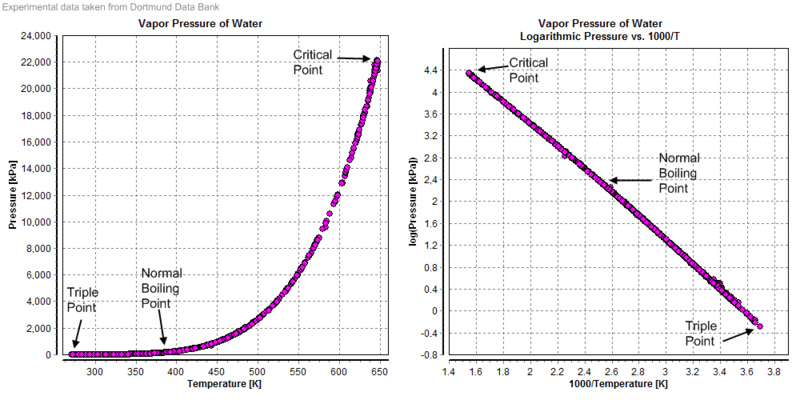
Compressibility
The compressibility of water is a function of pressure and temperature. At 0 °C, at the limit of zero pressure, the compressibility is 5.1×10−10 Pa−1. At the zero-pressure limit, the compressibility reaches a minimum of 4.4×10−10 Pa−1 around 45 °C before increasing again with increasing temperature. As the pressure is increased, the compressibility decreases, being 3.9×10−10 Pa−1 at 0 °C and 100 megapascals (1,000 bar).[39]
The bulk modulus of water is about 2.2 GPa.[40] The low compressibility of non-gases, and of water in particular, leads to their often being assumed as incompressible. The low compressibility of water means that even in the deep oceans at 4 km depth, where pressures are 40 MPa, there is only a 1.8% decrease in volume.[40]
Triple point
| Phases in stable equilibrium | Pressure | Temperature |
|---|---|---|
| liquid water, ice Ih, and water vapor | 611.657 Pa[41] | 273.16 K (0.01 °C) |
| liquid water, ice Ih, and ice III | 209.9 MPa | 251 K (−22 °C) |
| liquid water, ice III, and ice V | 350.1 MPa | −17.0 °C |
| liquid water, ice V, and ice VI | 632.4 MPa | 0.16 °C |
| ice Ih, Ice II, and ice III | 213 MPa | −35 °C |
| ice II, ice III, and ice V | 344 MPa | −24 °C |
| ice II, ice V, and ice VI | 626 MPa | −70 °C |
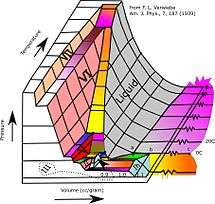 A 3-dimensional representation of the relationships between allotropes of ice amongst each other and in relation to liquid water and gaseous water.
A 3-dimensional representation of the relationships between allotropes of ice amongst each other and in relation to liquid water and gaseous water.
The temperature and pressure at which solid, liquid, and gaseous water coexist in equilibrium is called the triple point of water. This point is used to define the units of temperature (the kelvin, the SI unit of thermodynamic temperature and, indirectly, the degree Celsius and even the degree Fahrenheit).
As a consequence, water's triple point temperature, as measured in these units, is a prescribed value rather than a measured quantity.

This pressure is quite low, about 1⁄166 of the normal sea level barometric pressure of 101,325 Pa. The atmospheric surface pressure on planet Mars is 610.5 Pa, which is remarkably close to the triple point pressure. The altitude of this surface pressure was used to define zero-elevation or "sea level" on that planet.[42]
Although it is commonly named as "the triple point of water", the stable combination of liquid water, ice I, and water vapor is but one of several triple points on the phase diagram of water. Gustav Heinrich Johann Apollon Tammann in Göttingen produced data on several other triple points in the early 20th century. Kamb and others documented further triple points in the 1960s.[43][44][45]
Melting point
The melting point of ice is 0 °C (32 °F; 273 K) at standard pressure; however, pure liquid water can be supercooled well below that temperature without freezing if the liquid is not mechanically disturbed. It can remain in a fluid state down to its homogeneous nucleation point of about 231 K (−42 °C; −44 °F).[46] The melting point of ordinary hexagonal ice falls slightly under moderately high pressures, by 0.0073 °C (0.0131 °F)/atm[lower-alpha 6] or about 0.5 °C (0.90 °F)/70 atm[lower-alpha 7][47] as the stabilization energy of hydrogen bonding is exceeded by intermolecular repulsion, but as ice transforms into its allotropes (see crystalline states of ice) above 209.9 MPa (2,072 atm), the melting point increases markedly with pressure, i.e., reaching 355 K (82 °C) at 2.216 GPa (21,870 atm) (triple point of Ice VII[48]).
Electrical properties
Electrical conductivity
Pure water containing no exogenous ions is an excellent insulator, but not even "deionized" water is completely free of ions. Water undergoes auto-ionization in the liquid state, when two water molecules form one hydroxide anion (OH−
) and one hydronium cation (H
3O+
).
Because water is such a good solvent, it almost always has some solute dissolved in it, often a salt. If water has even a tiny amount of such an impurity, then it can conduct electricity far more readily.
It is known that the theoretical maximum electrical resistivity for water is approximately 18.2 MΩ·cm (182 kΩ·m) at 25 °C.[49] This figure agrees well with what is typically seen on reverse osmosis, ultra-filtered and deionized ultra-pure water systems used, for instance, in semiconductor manufacturing plants. A salt or acid contaminant level exceeding even 100 parts per trillion (ppt) in otherwise ultra-pure water begins to noticeably lower its resistivity by up to several kΩ·m.
In pure water, sensitive equipment can detect a very slight electrical conductivity of 0.05501 ± 0.0001 µS/cm at 25.00 °C.[49] Water can also be electrolyzed into oxygen and hydrogen gases but in the absence of dissolved ions this is a very slow process, as very little current is conducted. In ice, the primary charge carriers are protons (see proton conductor).[50] Ice was previously thought to have a small but measurable conductivity of 1×10−10 S cm−1, but this conductivity is now thought to almost entirely from surface defects, and without those, ice is an insulator with an immeasurably small conductivity.[31]
Polarity, hydrogen bonding and intermolecular structure

An important feature of water is its polar nature. The structure has a bent molecular geometry for the two hydrogens from the oxygen vertex. The oxygen atom also has two lone pairs of electrons. One effect usually ascribed to the lone pairs is that the H–O–H gas phase bend angle is 104.48°,[51] which is smaller than the typical tetrahedral angle of 109.47°. The lone pairs are closer to the oxygen atom than the electrons sigma bonded to the hydrogens, so they require more space. The increased repulsion of the lone pairs forces the O–H bonds closer to each other.[52]
Another effect of the electronic structure is that water is a polar molecule. Due to the difference in electronegativity, there is a bond dipole moment pointing from each H to the O, making the oxygen partially negative and each hydrogen partially positive. In addition, the lone pairs of electrons on the O are in the direction opposite to the hydrogen atoms. This results in a large molecular dipole, pointing from a positive region between the two hydrogen atoms to the negative region of the oxygen atom. The charge differences cause water molecules to be attracted to each other (the relatively positive areas being attracted to the relatively negative areas) and to other polar molecules. This attraction contributes to hydrogen bonding, and explains many of the properties of water, such as solvent action.[53]
Although hydrogen bonding is a relatively weak attraction compared to the covalent bonds within the water molecule itself, it is responsible for a number of water's physical properties. These properties include its relatively high melting and boiling point temperatures: more energy is required to break the hydrogen bonds between water molecules. In contrast, hydrogen sulfide (H
2S), has much weaker hydrogen bonding due to sulfur's lower electronegativity. H
2S is a gas at room temperature, in spite of hydrogen sulfide having nearly twice the molar mass of water. The extra bonding between water molecules also gives liquid water a large specific heat capacity. This high heat capacity makes water a good heat storage medium (coolant) and heat shield.
Proposed structures
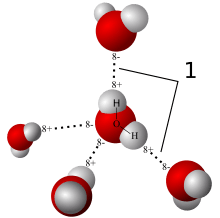
A single water molecule can participate in a maximum of four hydrogen bonds because it can accept two bonds using the lone pairs on oxygen and donate two hydrogen atoms. Other molecules like hydrogen fluoride, ammonia and methanol can also form hydrogen bonds. However, they do not show anomalous thermodynamic, kinetic or structural properties like those observed in water because none of them can form four hydrogen bonds: either they cannot donate or accept hydrogen atoms, or there are steric effects in bulky residues. In water, intermolecular tetrahedral structures form due to the four hydrogen bonds, thereby forming an open structure and a three-dimensional bonding network, resulting in the anomalous decrease in density when cooled below 4 °C. This repeated, constantly reorganizing unit defines a three-dimensional network extending throughout the liquid. This view is based upon neutron scattering studies and computer simulations, and it makes sense in the light of the unambiguously tetrahedral arrangement of water molecules in ice structures.
However, there is an alternative theory for the structure of water. In 2004, a controversial paper from Stockholm University suggested that water molecules in liquid form typically bind not to four but to only two others; thus forming chains and rings. The term "string theory of water" (which is not to be confused with the string theory of physics) was coined. These observations were based upon X-ray absorption spectroscopy that probed the local environment of individual oxygen atoms. Water, the team suggests, is a muddle of the two proposed structures. They say that it is a soup flecked with "icebergs" each comprising 100 or so loosely connected molecules that are relatively open and hydrogen bonded. The soup is made of the string structure and the icebergs of the tetrahedral structure.[54]
Cohesion and adhesion

Water molecules stay close to each other (cohesion), due to the collective action of hydrogen bonds between water molecules. These hydrogen bonds are constantly breaking, with new bonds being formed with different water molecules; but at any given time in a sample of liquid water, a large portion of the molecules are held together by such bonds.[55]
Water also has high adhesion properties because of its polar nature. On extremely clean/smooth glass the water may form a thin film because the molecular forces between glass and water molecules (adhesive forces) are stronger than the cohesive forces. In biological cells and organelles, water is in contact with membrane and protein surfaces that are hydrophilic; that is, surfaces that have a strong attraction to water. Irving Langmuir observed a strong repulsive force between hydrophilic surfaces. To dehydrate hydrophilic surfaces—to remove the strongly held layers of water of hydration—requires doing substantial work against these forces, called hydration forces. These forces are very large but decrease rapidly over a nanometer or less.[56] They are important in biology, particularly when cells are dehydrated by exposure to dry atmospheres or to extracellular freezing.[57]
Surface tension


Water has a high surface tension of 71.99 mN/m at 25 °C,[58] caused by the strong cohesion between water molecules, the highest of the common non-ionic, non-metallic liquids. This can be seen when small quantities of water are placed onto a sorption-free (non-adsorbent and non-absorbent) surface, such as polyethylene or Teflon, and the water stays together as drops. Just as significantly, air trapped in surface disturbances forms bubbles, which sometimes last long enough to transfer gas molecules to the water.
Another surface tension effect is capillary waves, which are the surface ripples that form around the impacts of drops on water surfaces, and sometimes occur with strong subsurface currents flowing to the water surface. The apparent elasticity caused by surface tension drives the waves. Additionally, the surface tension of water allows certain insects to walk on the surface of water. This is caused by the strength of the hydrogen bonds, making it difficult to break the surface of water. These insects, including the raft spider, are more dense than water and yet are still able to walk on the surface. [59]
Capillary action
Due to an interplay of the forces of adhesion and surface tension, water exhibits capillary action whereby water rises into a narrow tube against the force of gravity. Water adheres to the inside wall of the tube and surface tension tends to straighten the surface causing a surface rise and more water is pulled up through cohesion. The process continues as the water flows up the tube until there is enough water such that gravity balances the adhesive force.
Surface tension and capillary action are important in biology. For example, when water is carried through xylem up stems in plants, the strong intermolecular attractions (cohesion) hold the water column together and adhesive properties maintain the water attachment to the xylem and prevent tension rupture caused by transpiration pull.
Water as a solvent

Water is also a good solvent, due to its polarity. Substances that will mix well and dissolve in water (e.g. salts) are known as hydrophilic ("water-loving") substances, while those that do not mix well with water (e.g. fats and oils), are known as hydrophobic ("water-fearing") substances. The ability of a substance to dissolve in water is determined by whether or not the substance can match or better the strong attractive forces that water molecules generate between other water molecules. If a substance has properties that do not allow it to overcome these strong intermolecular forces, the molecules are "pushed out" from the water, and do not dissolve. Contrary to the common misconception, water and hydrophobic substances do not "repel", and the hydration of a hydrophobic surface is energetically, but not entropically, favorable.
When an ionic or polar compound enters water, it is surrounded by water molecules (Hydration). The relatively small size of water molecules (~ 3 Angstroms) allows many water molecules to surround one molecule of solute. The partially negative dipole ends of the water are attracted to positively charged components of the solute, and vice versa for the positive dipole ends.
In general, ionic and polar substances such as acids, alcohols, and salts are relatively soluble in water, and non-polar substances such as fats and oils are not. Non-polar molecules stay together in water because it is energetically more favorable for the water molecules to hydrogen bond to each other than to engage in van der Waals interactions with non-polar molecules.
An example of an ionic solute is table salt; the sodium chloride, NaCl, separates into Na+
cations and Cl−
anions, each being surrounded by water molecules. The ions are then easily transported away from their crystalline lattice into solution. An example of a nonionic solute is table sugar. The water dipoles make hydrogen bonds with the polar regions of the sugar molecule (OH groups) and allow it to be carried away into solution.
Quantum tunneling
The quantum tunneling dynamics in water was reported as early as 1992. At that time it was known that there are motions which destroy and regenerate the weak hydrogen bond by internal rotations of the substituent water monomers.[60] On 18 March 2016, it was reported that the hydrogen bond can be broken by quantum tunneling in the water hexamer. Unlike previously reported tunneling motions in water, this involved the concerted breaking of two hydrogen bonds.[61] Later in the same year, the discovery of the quantum tunneling of water molecules was reported.[62]
Chemical properties in nature
Geochemistry
Action of water on rock over long periods of time typically leads to weathering and water erosion, physical processes that convert solid rocks and minerals into soil and sediment, but under some conditions chemical reactions with water occur as well, resulting in metasomatism or mineral hydration, a type of chemical alteration of a rock which produces clay minerals. It also occurs when Portland cement hardens.
Water ice can form clathrate compounds, known as clathrate hydrates, with a variety of small molecules that can be embedded in its spacious crystal lattice. The most notable of these is methane clathrate, 4 CH
4·23H
2O, naturally found in large quantities on the ocean floor.
Acidity
Pure water has the concentration of hydroxide ions (OH−
) equal to that of the hydronium (H
3O+
) or hydrogen (H+
) ions, which gives pH of 7 at 298 K. In practice, pure water is very difficult to produce. Water left exposed to air for any length of time will dissolve carbon dioxide, forming a dilute solution of carbonic acid, with a limiting pH of about 5.7. As cloud droplets form in the atmosphere and as raindrops fall through the air minor amounts of CO
2 are absorbed, and thus most rain is slightly acidic. If high amounts of nitrogen and sulfur oxides are present in the air, they too will dissolve into the cloud and rain drops, producing acid rain.
Electromagnetic absorption
Water is relatively transparent to visible light, near ultraviolet light, and far-red light, but it absorbs most ultraviolet light, infrared light, and microwaves. Most photoreceptors and photosynthetic pigments utilize the portion of the light spectrum that is transmitted well through water. Microwave ovens take advantage of water's opacity to microwave radiation to heat the water inside of foods. The very weak onset of absorption in the red end of the visible spectrum lends water its intrinsic blue hue (see Color of water).
Heavy water and isotopologues
Several isotopes of both hydrogen and oxygen exist, giving rise to several known isotopologues of water.
Hydrogen occurs naturally in three isotopes. The most common isotope, 1
H, sometimes called protium, accounts for more than 99.98% of hydrogen in water and consists of only a single proton in its nucleus. A second stable isotope, deuterium (chemical symbol D or 2
H), has an additional neutron. Deuterium oxide, D
2O, is also known as heavy water because of its higher density. It is used in nuclear reactors as a neutron moderator. The third isotope, tritium (chemical symbol T or 3
H) has 1 proton and 2 neutrons, and is radioactive, decaying with a half-life of 4500 days. THO exists in nature only in minute quantities, being produced primarily via cosmic ray-induced nuclear reactions in the atmosphere. Water with one protium and one deuterium atom HDO occurs naturally in ordinary water in low concentrations (~0.03%) and D
2O in far lower amounts (0.000003%) and any such molecules are temporary as the atoms recombine.
The most notable physical differences between H
2O and D
2O, other than the simple difference in specific mass, involve properties that are affected by hydrogen bonding, such as freezing and boiling, and other kinetic effects. This is because the nucleus of deuterium is twice as heavy as protium, and this causes noticeable differences in bonding energies. The difference in boiling points allows the isotopologues to be separated. The self-diffusion coefficient of H
2O at 25 °C is 23% higher than the value of D
2O.[63] Because water molecules exchange hydrogen atoms with one another, hydrogen deuterium oxide (DOH) is much more common in low-purity heavy water than pure dideuterium monoxide D
2O.
Consumption of pure isolated D
2O may affect biochemical processes – ingestion of large amounts impairs kidney and central nervous system function. Small quantities can be consumed without any ill-effects; humans are generally unaware of taste differences,[64] but sometimes report a burning sensation[65] or sweet flavor.[66] Very large amounts of heavy water must be consumed for any toxicity to become apparent. Rats, however, are able to avoid heavy water by smell, and it is toxic to many animals.[67]
Oxygen also has three stable isotopes, with 16
O present in 99.76%, 17
O in 0.04%, and 18
O in 0.2% of water molecules.[68]
Light water refers to deuterium-depleted water (DDW), water in which the deuterium content has been reduced below the standard 155 ppm level.
Standard water
Vienna Standard Mean Ocean Water is the current international standard for water isotopes. Naturally occurring water is almost completely composed of the neutron-less hydrogen isotope protium. Only 155 ppm include deuterium (2
H or D), a hydrogen isotope with one neutron, and fewer than 20 parts per quintillion include tritium (3
H or T), which has two neutrons.
Reactions
Acid-base reactions
Water is amphoteric: it has the ability to act as either an acid or a base in chemical reactions.[69] According to the Brønsted-Lowry definition, an acid is a proton (H+
) donor and a base is a proton acceptor.[70] When reacting with a stronger acid, water acts as a base; when reacting with a stronger base, it acts as an acid.[70] For instance, water receives an H+
ion from HCl when hydrochloric acid is formed:
In the reaction with ammonia, NH
3, water donates a H+
ion, and is thus acting as an acid:
Because the oxygen atom in water has two lone pairs, water often acts as a Lewis base, or electron pair donor, in reactions with Lewis acids, although it can also react with Lewis bases, forming hydrogen bonds between the electron pair donors and the hydrogen atoms of water. HSAB theory describes water as both a weak hard acid and a weak hard base, meaning that it reacts preferentially with other hard species:
- + → H
3O+
- + → Fe(H
2O)3+
6
- + → Cl(H
2O)−
6
When a salt of a weak acid or of a weak base is dissolved in water, water can partially hydrolyze the salt, producing the corresponding base or acid, which gives aqueous solutions of soap and baking soda their basic pH:
- Na
2CO
3 + H
2O ⇌ NaOH + NaHCO
3
Ligand chemistry
Water's Lewis base character makes it a common ligand in transition metal complexes, examples of which range from solvated ions, such as Fe(H
2O)3+
6, to perrhenic acid, which contains two water molecules coordinated to a rhenium atom, and various solid hydrates, such as CoCl
2·6H
2O. Water is typically a monodentate ligand–it forms only one bond with the central atom.[71]
Organic chemistry
As a hard base, water reacts readily with organic carbocations; for example in an hydration reaction, a hydroxyl group (OH−
) and an acidic proton are added to the two carbon atoms bonded together in the carbon-carbon double bond, resulting in an alcohol. When addition of water to an organic molecule cleaves the molecule in two, hydrolysis is said to occur. Notable examples of hydrolysis are the saponification of fats and the digestion of proteins and polysaccharides. Water can also be a leaving group in SN2 substitution and E2 elimination reactions; the latter is then known as a dehydration reaction.
Water in redox reactions
Water contains hydrogen in the oxidation state +1 and oxygen in the oxidation state −2.[72] It oxidizes chemicals such as hydrides, alkali metals, and some alkaline earth metals.[73][74][75] One example of an alkali metal reacting with water is:[76]
- 2 Na + 2 H
2O → H
2 + 2 Na+
+ 2 OH−
Some other reactive metals, such as aluminum and beryllium, are oxidized by water as well, but their oxides adhere to the metal and form a passive protective layer.[77] Note, however, that the rusting of iron is a reaction between iron and oxygen[78] that is dissolved in water, not between iron and water.
Water can be oxidized to emit oxygen gas, but very few oxidants react with water even if their reduction potential is greater than the potential of O
2/H
2O. Almost all such reactions require a catalyst.[79]
An example of the oxidation of water is:
- 4 AgF
2 + 2 H
2O → 4 AgF + 4 HF + O
2
Electrolysis
Water can be split into its constituent elements, hydrogen and oxygen, by passing an electric current through it. This process is called electrolysis. The cathode half reaction is:
- 2 H+
+ 2
e−
→ H
2
The anode half reaction is:
- 2 H
2O → O
2 + 4 H+
+ 4
e−
The gases produced bubble to the surface, where they can be collected. The standard potential of the water electrolysis cell (when heat is added to the reaction) is a minimum of 1.23 V at 25 °C. The operating potential is actually 1.48 V (or above) in practical electrolysis when heat input is negligible.
History
Henry Cavendish showed that water was composed of oxygen and hydrogen in 1781.[80] The first decomposition of water into hydrogen and oxygen, by electrolysis, was done in 1800 by English chemist William Nicholson and Anthony Carlisle.[80][81] In 1805, Joseph Louis Gay-Lussac and Alexander von Humboldt showed that water is composed of two parts hydrogen and one part oxygen.[82]
Gilbert Newton Lewis isolated the first sample of pure heavy water in 1933.[83]
The properties of water have historically been used to define various temperature scales. Notably, the Kelvin, Celsius, Rankine, and Fahrenheit scales were, or currently are, defined by the freezing and boiling points of water. The less common scales of Delisle, Newton, Réaumur and Rømer were defined similarly. The triple point of water is a more commonly used standard point today.[84]
See also
Notes
- 1 2 Vienna Standard Mean Ocean Water (VSMOW), used for calibration, melts at 273.1500089(10) K (0.000089(10) °C, and boils at 373.1339 K (99.9839 °C). Other isotopic compositions melt or boil at slightly different temperatures.
- ↑ A commonly quoted value of 15.7 used mainly in organic chemistry for the pKa of water is incorrect.[7]
- ↑ Both acid and base names exist for water because it is amphoteric (able to react both as an acid or an alkali)
- ↑ (1-0.95865/1.00000) × 100% = 4.135%
- ↑ Adiabatic cooling resulting from the ideal gas law
- ↑ The source gives it as 0.0072°C/atm. However the author defines an atmosphere as 1,000,000 dynes/cm2 (a bar). Using the standard definition of atmosphere, 1,013,250 dynes/cm2, it works out to 0.0073°C/atm
- ↑ Using the fact that 0.5/0.0073 = 68.5
References
- ↑ "Definition of Hydrol". Merriam-Webster. (subscription required (help)).
- 1 2 Braun, Charles L.; Smirnov, Sergei N. (1993-08-01). "Why is water blue?". Journal of Chemical Education. 70 (8): 612. Bibcode:1993JChEd..70..612B. doi:10.1021/ed070p612. ISSN 0021-9584.
- ↑ Water in Linstrom, P.J.; Mallard, W.G. (eds.) NIST Chemistry WebBook, NIST Standard Reference Database Number 69. National Institute of Standards and Technology, Gaithersburg MD. http://webbook.nist.gov (retrieved 2016-5-27)
- 1 2 3 Anatolievich, Kiper Ruslan. "Properties of substance: water".
- ↑ Lide, David R. (2003-06-19). CRC Handbook of Chemistry and Physics, 84th Edition. CRC Handbook. CRC Press. Vapor Pressure of Water From 0 to 370° C in Sec. 6. ISBN 9780849304842.
- ↑ Lide, David R. (2003-06-19). CRC Handbook of Chemistry and Physics, 84th Edition. CRC Handbook. CRC Press. Chapter 8: Dissociation Constants of Inorganic Acids and Bases. ISBN 9780849304842.
- ↑ "What is the pKa of Water". University of California, Davis.
- ↑ Ramires, Maria L. V.; Castro, Carlos A. Nieto de; Nagasaka, Yuchi; Nagashima, Akira; Assael, Marc J.; Wakeham, William A. (1995-05-01). "Standard Reference Data for the Thermal Conductivity of Water". Journal of Physical and Chemical Reference Data. 24 (3): 1377–1381. doi:10.1063/1.555963. ISSN 0047-2689.
- ↑ Lide, David R. (2003-06-19). CRC Handbook of Chemistry and Physics, 84th Edition. CRC Handbook. CRC Press. 8—Concentrative Properties of Aqueous Solutions: Density, Refractive Index, Freezing Point Depression, and Viscosity. ISBN 9780849304842.
- ↑ Lide, David R. (2003-06-19). CRC Handbook of Chemistry and Physics, 84th Edition. CRC Handbook. CRC Press. 6.186. ISBN 9780849304842.
- ↑ Lide, David R. (2003-06-19). CRC Handbook of Chemistry and Physics, 84th Edition. CRC Handbook. CRC Press. 9—Dipole Moments. ISBN 9780849304842.
- 1 2 3 Water in Linstrom, P.J.; Mallard, W.G. (eds.) NIST Chemistry WebBook, NIST Standard Reference Database Number 69. National Institute of Standards and Technology, Gaithersburg MD. http://webbook.nist.gov (retrieved 2014-06-01)
- ↑ Greenwood, Norman N.; Earnshaw, Alan (1997). Chemistry of the Elements (2nd ed.). Butterworth-Heinemann. p. 620. ISBN 0-08-037941-9.
- ↑ "Water, the Universal Solvent". USGS.
- ↑ Reece, Jane B. (31 October 2013). Campbell Biology (10 ed.). Pearson. p. 48. ISBN 9780321775658.
- ↑ Reece, Jane B. (31 October 2013). Campbell Biology (10 ed.). Pearson. p. 44. ISBN 9780321775658.
- 1 2 Leigh, G. J.; et al. (1998). Principles of chemical nomenclature: a guide to IUPAC recommendations (PDF). Blackwell Science Ltd, UK. p. 34. ISBN 0-86542-685-6. Archived (PDF) from the original on 2011-07-26.
- ↑ Nomenclature of Inorganic Chemistry: IUPAC Recommendations 2005 (PDF). Royal Society of Chemistry. 22 Nov 2005. p. 85. ISBN 978-0-85404-438-2. Retrieved 2016-07-31.
- ↑ Leigh, G. J.; et al. (1998). Principles of chemical nomenclature: a guide to IUPAC recommendations (PDF). IUPAC, Commission on Nomenclature of Organic Chemistry. Blackwell Science Ltd, UK. p. 99. ISBN 0-86542-685-6. Archived (PDF) from the original on 2011-07-26.
- ↑ "Tetrahydropyran". Pubchem. National Institutes of Health. Retrieved 2016-07-31.
- ↑ "Compound Summary for CID 22247451". Pubchem Compound Database. National Center for Biotechnology Information.
- ↑ Leigh, G. J.; et al. (1998). Principles of chemical nomenclature: a guide to IUPAC recommendations (PDF). Blackwell Science Ltd, UK. pp. 27–28. ISBN 0-86542-685-6. Archived (PDF) from the original on 2011-07-26.
- ↑ Campbell, Neil A.; Brad Williamson; Robin J. Heyden (2006). Biology: Exploring Life. Boston, Massachusetts: Pearson Prentice Hall. ISBN 0-13-250882-6.
- ↑ "Water (Code C65147)". NCI Thesaurus. National Cancer Institute. Retrieved 2016-08-01.
- ↑ Smith, Jared D.; Christopher D. Cappa; Kevin R. Wilson; Ronald C. Cohen; Phillip L. Geissler; Richard J. Saykally (2005). "Unified description of temperature-dependent hydrogen bond rearrangements in liquid water" (PDF). Proc. Natl. Acad. Sci. USA. 102 (40): 14171–14174. Bibcode:2005PNAS..10214171S. doi:10.1073/pnas.0506899102. PMC 1242322
 . PMID 16179387.
. PMID 16179387. - ↑ Deguchi, Shigeru; Tsujii, Kaoru (2007-06-19). "Supercritical water: a fascinating medium for soft matter". Soft Matter. 3 (7): 797. Bibcode:2007SMat....3..797D. doi:10.1039/b611584e. ISSN 1744-6848.
- ↑ NASA – Oceans of Climate Change. Nasa.gov (2009-04-22). Retrieved on 2011-11-22.
- ↑ Lide, David R. (2003-06-19). CRC Handbook of Chemistry and Physics, 84th Edition. CRC Handbook. CRC Press. Chapter 6: Properties of Ice and Supercooled Water. ISBN 9780849304842.
- ↑ Lide, David R. (2003-06-19). CRC Handbook of Chemistry and Physics, 84th Edition. CRC Handbook. CRC Press. 6. Properties of Water and Steam as a Function of Temperature and Pressure. ISBN 9780849304842.
- ↑ "Decree on weights and measures". April 7, 1795.
Gramme, le poids absolu d'un volume d'eau pure égal au cube de la centième partie du mètre, et à la température de la glace fondante.
- 1 2 3 4 Greenwood, Norman N.; Earnshaw, Alan (1997). Chemistry of the Elements (2nd ed.). Butterworth-Heinemann. p. 625. ISBN 0-08-037941-9.
- ↑ Shell, Scott M.; Debenedetti, Pablo G. & Panagiotopoulos, Athanassios Z. (2002). "Molecular structural order and anomalies in liquid silica" (PDF). Phys. Rev. E. 66: 011202. arXiv:cond-mat/0203383
 . Bibcode:2002PhRvE..66a1202S. doi:10.1103/PhysRevE.66.011202.
. Bibcode:2002PhRvE..66a1202S. doi:10.1103/PhysRevE.66.011202. - 1 2 3 4 5 Perlman, Howard. "Water Density". The USGS Water Science School. Retrieved 2016-06-03.
- ↑ Zumdahl, Steven S.; Zumdahl, Susan A. (2013-01-01). Chemistry (9th ed.). Cengage Learning. p. 938. ISBN 978-1-13-361109-7.
- ↑ Loerting, Thomas; Salzmann, Christoph; Kohl, Ingrid; Mayer, Erwin; Hallbrucker, Andreas (2001-01-01). "A second distinct structural "state" of high-density amorphous ice at 77 K and 1 bar". Physical Chemistry Chemical Physics. 3 (24): 5355–5357. doi:10.1039/b108676f. ISSN 1463-9084.
- ↑ Greenwood, Norman N.; Earnshaw, Alan (1997). Chemistry of the Elements (2nd ed.). Butterworth-Heinemann. p. 624. ISBN 0-08-037941-9.
- ↑ Zumdahl, Steven S.; Zumdahl, Susan A. (2013-01-01). Chemistry (9th ed.). Cengage Learning. p. 493. ISBN 978-1-13-361109-7.
- 1 2 3 "Can the ocean freeze?". National Ocean Service. National Oceanic and Atmospheric Administration. Retrieved 2016-06-09.
- ↑ Fine, R.A. & Millero, F.J. (1973). "Compressibility of water as a function of temperature and pressure". Journal of Chemical Physics. 59 (10): 5529. Bibcode:1973JChPh..59.5529F. doi:10.1063/1.1679903.
- ↑ Review of the vapour pressures of ice and supercooled water for atmospheric applications. D. M. Murphy and T. Koop (2005) Quarterly Journal of the Royal Meteorological Society, 131, 1539.
- ↑ Zeitler, W.; Ohlhof, T.; Ebner, H. (2000). "Recomputation of the global Mars control-point network" (PDF). Photogrammetric Engineering & Remote Sensing. 66 (2): 155–161. Retrieved 2009-12-26.
- ↑ Schlüter, Oliver (2003-07-28). "Impact of High Pressure — Low Temperature Processes on Cellular Materials Related to Foods" (PDF). Technischen Universität Berlin.
- ↑ Tammann, Gustav H.J.A (1925). "The States Of Aggregation". Constable And Company.
- ↑ Lewis, William C.M. & Rice, James (1922). A System of Physical Chemistry. Longmans, Green and Co.
- ↑ Debenedetti, P. G. & Stanley, H. E. (2003). "Supercooled and Glassy Water" (PDF). Physics Today. 56 (6): 40–46. Bibcode:2003PhT....56f..40D. doi:10.1063/1.1595053.
- ↑ Sharp, Robert Phillip (1988-11-25). Living Ice: Understanding Glaciers and Glaciation. Cambridge University Press. p. 27. ISBN 0-521-33009-2.
- ↑ "Revised Release on the Pressure along the Melting and Sublimation Curves of Ordinary Water Substance" (PDF). IAPWS. September 2011. Retrieved 2013-02-19.
- 1 2 Light, Truman S.; Licht, Stuart; Bevilacqua, Anthony C.; Morash, Kenneth R. (2005-01-01). "The Fundamental Conductivity and Resistivity of Water". Electrochemical and Solid-State Letters. 8 (1): E16–E19. doi:10.1149/1.1836121. ISSN 1099-0062.
- ↑ Crofts, A. (1996). "Lecture 12: Proton Conduction, Stoichiometry". University of Illinois at Urbana-Champaign. Retrieved 2009-12-06.
- ↑ Hoy, AR; Bunker, PR (1979). "A precise solution of the rotation bending Schrödinger equation for a triatomic molecule with application to the water molecule". Journal of Molecular Spectroscopy. 74: 1–8. Bibcode:1979JMoSp..74....1H. doi:10.1016/0022-2852(79)90019-5.
- ↑ Zumdahl, Steven S.; Zumdahl, Susan A. (2013-01-01). Chemistry (9th ed.). Cengage Learning. p. 393. ISBN 978-1-13-361109-7.
- ↑ Campbell, Mary K. & Farrell, Shawn O. (2007). Biochemistry (6th ed.). Cengage Learning. pp. 37–38. ISBN 978-0-495-39041-1.
- ↑ Ball, Philip (2008). "Water—an enduring mystery". Nature. 452 (7185): 291–292. Bibcode:2008Natur.452..291B. doi:10.1038/452291a. PMID 18354466.
- ↑ Campbell, Neil A. & Reece, Jane B. (2009). Biology (8th ed.). Pearson. p. 47. ISBN 978-0-8053-6844-4.
- ↑ Chiavazzo, Eliodoro; Fasano, Matteo; Asinari, Pietro; Decuzzi, Paolo (2014). "Scaling behaviour for the water transport in nanoconfined geometries". Nature Communications. 5: 4565. Bibcode:2014NatCo...5E4565C. doi:10.1038/ncomms4565.
- ↑ "Physical Forces Organizing Biomolecules" (PDF). Biophysical Society. Archived from the original on August 7, 2007.
- ↑ Lide, David R. (2003-06-19). CRC Handbook of Chemistry and Physics, 84th Edition. CRC Press. Water in Table Surface Tension of Common Liquids. ISBN 9780849304842.
- ↑ Campbell, Neil (2011). Biology. Benjamin Cummings. p. 48. ISBN 0321558235.
- ↑ Pugliano, N. (1992-11-01). "Vibration-Rotation-Tunneling Dynamics in Small Water Clusters". Lawrence Berkeley Lab., CA (United States): 6. doi:10.2172/6642535.
- ↑ Richardson, Jeremy O.; Pérez, Cristóbal; Lobsiger, Simon; Reid, Adam A.; Temelso, Berhane; Shields, George C.; Kisiel, Zbigniew; Wales, David J.; Pate, Brooks H. (2016-03-18). "Concerted hydrogen-bond breaking by quantum tunneling in the water hexamer prism". Science. 351 (6279): 1310–1313. Bibcode:2016Sci...351.1310R. doi:10.1126/science.aae0012. ISSN 0036-8075. PMID 26989250. Retrieved 2016-04-23.
- ↑ Kolesnikov, Alexander I. (2016-04-22). "Quantum Tunneling of Water in Beryl: A New State of the Water Molecule". Physical Review Letters. 116 (16): 167802. Bibcode:2016PhRvL.116p7802K. doi:10.1103/PhysRevLett.116.167802. PMID 27152824. Retrieved 2016-04-23.
- ↑ Hardy, Edme H.; Zygar, Astrid; Zeidler, Manfred D.; Holz, Manfred; Sacher, Frank D. (2001). "Isotope effect on the translational and rotational motion in liquid water and ammonia". J. Chem Phys. 114 (7): 3174–3181. Bibcode:2001JChPh.114.3174H. doi:10.1063/1.1340584.
- ↑ Urey, Harold C.; et al. (15 Mar 1935). "Concerning the Taste of Heavy Water". Science. 81 (2098). New York: The Science Press. p. 273. doi:10.1126/science.81.2098.273-a.
- ↑ "Experimenter Drinks 'Heavy Water' at $5,000 a Quart". Popular Science Monthly. 126 (4). New York: Popular Science Publishing. Apr 1935. p. 17. Retrieved 7 Jan 2011.
- ↑ Müller, Grover C. (June 1937). "Is 'Heavy Water' the Fountain of Youth?". Popular Science Monthly. 130 (6). New York: Popular Science Publishing. pp. 22–23. Retrieved 7 Jan 2011.
- ↑ Miller, Inglis J., Jr.; Mooser, Gregory (Jul 1979). "Taste Responses to Deuterium Oxide". Physiology & Behavior. 23 (1): 69–74. doi:10.1016/0031-9384(79)90124-0.
- ↑ "Guideline on the Use of Fundamental Physical Constants and Basic Constants of Water" (PDF). IAPWS. 2001.
- ↑ Zumdahl, Steven S.; Zumdahl, Susan A. (2013-01-01). Chemistry (9th ed.). Cengage Learning. p. 659. ISBN 978-1-13-361109-7.
- 1 2 Zumdahl, Steven S.; Zumdahl, Susan A. (2013-01-01). Chemistry (9th ed.). Cengage Learning. p. 654. ISBN 978-1-13-361109-7.
- ↑ Zumdahl, Steven S.; Zumdahl, Susan A. (2013-01-01). Chemistry (9th ed.). Cengage Learning. p. 984. ISBN 978-1-13-361109-7.
- ↑ Zumdahl, Steven S.; Zumdahl, Susan A. (2013-01-01). Chemistry (9th ed.). Cengage Learning. p. 171. ISBN 978-1-13-361109-7.
- ↑ "Hydrides". Chemwiki. UC Davis. Retrieved 2016-06-25.
- ↑ Zumdahl, Steven S.; Zumdahl, Susan A. (2013-01-01). Chemistry (9th ed.). Cengage Learning. p. 932. ISBN 978-1-13-361109-7.
- ↑ Zumdahl, Steven S.; Zumdahl, Susan A. (2013-01-01). Chemistry (9th ed.). Cengage Learning. p. 936. ISBN 978-1-13-361109-7.
- ↑ Zumdahl, Steven S.; Zumdahl, Susan A. (2013-01-01). Chemistry (9th ed.). Cengage Learning. p. 338. ISBN 978-1-13-361109-7.
- ↑ Zumdahl, Steven S.; Zumdahl, Susan A. (2013-01-01). Chemistry (9th ed.). Cengage Learning. p. 862. ISBN 978-1-13-361109-7.
- ↑ Zumdahl, Steven S.; Zumdahl, Susan A. (2013-01-01). Chemistry (9th ed.). Cengage Learning. p. 981. ISBN 978-1-13-361109-7.
- ↑ Charlot, G. (2007). Qualitative Inorganic Analysis. Read Books. p. 275. ISBN 1-4067-4789-0.
- 1 2 Greenwood, Norman N.; Earnshaw, Alan (1997). Chemistry of the Elements (2nd ed.). Butterworth-Heinemann. p. 601. ISBN 0-08-037941-9.
- ↑ "Enterprise and electrolysis...". Royal Society of Chemistry. August 2003. Retrieved 2016-06-24.
- ↑ "Joseph Louis Gay-Lussac, French chemist (1778–1850)". 1902 Encyclopedia. Footnote 122-1. Retrieved 2016-05-26.
- ↑ Lewis, G. N.; MacDonald, R. T. (1933). "Concentration of H2 Isotope". The Journal of Chemical Physics. 1 (6): 341. Bibcode:1933JChPh...1..341L. doi:10.1063/1.1749300.
- ↑ A Brief History of Temperature Measurement. Home.comcast.net. Retrieved on 2011-11-22.
External links
| Wikimedia Commons has media related to Water molecule. |
| Wikimedia Commons has media related to Water. |
- "Water Properties and Measurements". usgs.gov. United States Geological Survey. May 2, 2016. Retrieved August 31, 2016.
- Release on the IAPWS Formulation 1995 for the Thermodynamic Properties of Ordinary Water Substance for General and Scientific Use (simpler formulation)
- Online calculator using the IAPWS Supplementary Release on Properties of Liquid Water at 0.1 MPa, September 2008
- Chaplin, Martin. "Water Structure and Science". London South Bank University. Retrieved 2009-07-07.
- Calculation of vapor pressure, liquid density, dynamic liquid viscosity, surface tension of water
- Water Density Calculator
- Why does ice float in my drink?, NASA
![]() Wikiversity has small "student" steam tables suitable for classroom use.
Wikiversity has small "student" steam tables suitable for classroom use.



